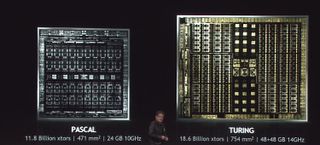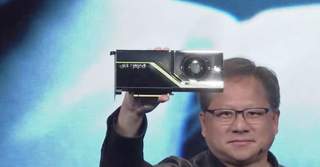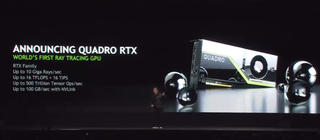Nvidia Launches Turing Architecture, Quadro RTX Ray-Tracing GPU

Nvidia’s CEO Jensen Huang took the wraps off of the company’s next-generation Turing graphics architecture today at the SIGGRAPH conference in Vancouver. And in self-referencing fashion, he called it “the greatest leap since the invention of the CUDA GPU in 2006.” That’s thanks in part to the introduction of dedicated ray tracing (RT) cores, alongside AI-focused Tensor Cores (the latter of which made their Nvidia debut on the company’s Volta-based cards like the Titan V, in 2017).
The company says these two specialized compute engines, alongside general compute improvements, will deliver new levels of hybrid rendering. In this initial announcement at least, Nvidia is focusing on the visual effects industry, with promises of “cinematic-quality interactive experiences, amazing new effects powered by neural networks and fluid interactivity on highly complex models.”

While ray tracing has been promised (and demoed) for several years by Nvidia and others, it looks like this feature will be a hallmark of Turing-based GPUs, with Huang hyping its arrival as “the Holy Grail of our industry.”

According to Nvidia, the first three Turing-based graphics cards to arrive will be the Quadro RTX 8000, the RTX 6000, and the RTX 5000. The company also claims the chips can simulate real-world scenarios at “6x” the speed of Pascal-based cards. This is reportedly accomplished by a combination of the RT and Tensor cores, which together accelerate real-time ray tracing by “up to 25x” the abilities of Pascal-based chips. Further cementing the video production angle, the company points out that GPU nodes can render final-frame effects at "more than 30x the speed of CPU nodes."
| GPU | Memory | Memory with NVLink | Ray Tracing | CUDA Cores | Tensor Cores |
|---|---|---|---|---|---|
| Quadro RTX 8000 | 48GB | 96GB | 10 GigaRays / sec | 4,608 | 576 |
| Quadro RTX 6000 | 24GB | 48GB | 10 GigaRays / sec | 4,608 | 576 |
| Quadro RTX 5000 | 16GB | 32GB | 6 GigaRays / sec | 3,072 | 384 |
These cards don't come cheap. Nvidia estimates that the RTX 8000 will carry a street price of $10,000 followed by the RTX 6000 for $6,300 and the RTX 5000 for $2,300.

Coming two years and a few months after the reveal of the company’s Pascal GPUs (found in current-generation professional and gaming cards like the GeForce GTX 1080), Turing is Nvidia’s eighth-generation GPU architecture, and the result of "more than 10,000 engineering-years" of effort, according to the company.
| Row 0 - Cell 0 | Transistors | Die Size |
| Turing | 18.6 Billion | 754mm2 |
| Pascal | 11.8 Billion | 471mm2 |
| Volta (V100) | 21 Billion | 815mm2 |
Huang revealed a few details of the Turing die, which measures 754mm2 and comes bristling with 18.6 billion transistors. That's a considerable step forward from Pascal's 11.8 billion transistors on a 471mm2 die, but still falls short of the industry-leading Volta die. Other highlights include the 100 GB/s NVLink interface and support for 8K DisplayPort.
Stay on the Cutting Edge
Join the experts who read Tom's Hardware for the inside track on enthusiast PC tech news — and have for over 25 years. We'll send breaking news and in-depth reviews of CPUs, GPUs, AI, maker hardware and more straight to your inbox.

The new architecture isn’t all about AI and RT cores, however. Nvidia says Turing also features a new SM (streaming multiprocessor) architecture, and a new unified cache that has twice the bandwidth of previous-generation GPUs. These new chips will reportedly sport up to 4,608 CUDA cores, although that’s less than the 5,120 found on the Volta-based Titan V. The tensor cores enable up to 125 TFLOPS of FP16, 250 TOPS of INT8, and 500 TOPS of INT4. Also, dedicated ray-tracing RT Cores accelerate the computation of how light and sound travel in 3D environments at up to 10 GigaRays per second.
Given the differences in architectures and components, we’ll of course have to wait to see how the Turing chips compare to previous GPUs in terms of general performance. And for those primarily interested in gaming, the specialized cores mean it could be years before gamers see lots of AAA titles that benefit from this cutting-edge tech. But true to form, Nvidia says it’s broadening its developer-friendly RTX platform with “new AI, ray-tracing, and simulation SDKs” to spur innovation (and adoption of its tech) on the software side.
Nvidia announced that over two dozen graphics applications will support RTX, including Epic Games' Unreal Engine and Adobe Dimensions CC, a new 3D imaging app from the makers of Photoshop.
Eager to find out more? Nvidia says Turing-based Quadro GPUs will be available sometime in the fourth quarter of this year. But with a teased event next week at Gamescomm in Germany and only six weeks to go before we officially hit Q4, we suspect Nvidia will have more to say about Turing--and perhaps other cards--sooner rather than later.
After a rough start with the Mattel Aquarius as a child, Matt built his first PC in the late 1990s and ventured into mild PC modding in the early 2000s. He’s spent the last 15 years covering emerging technology for Smithsonian, Popular Science, and Consumer Reports, while testing components and PCs for Computer Shopper, PCMag and Digital Trends.
Most Popular






